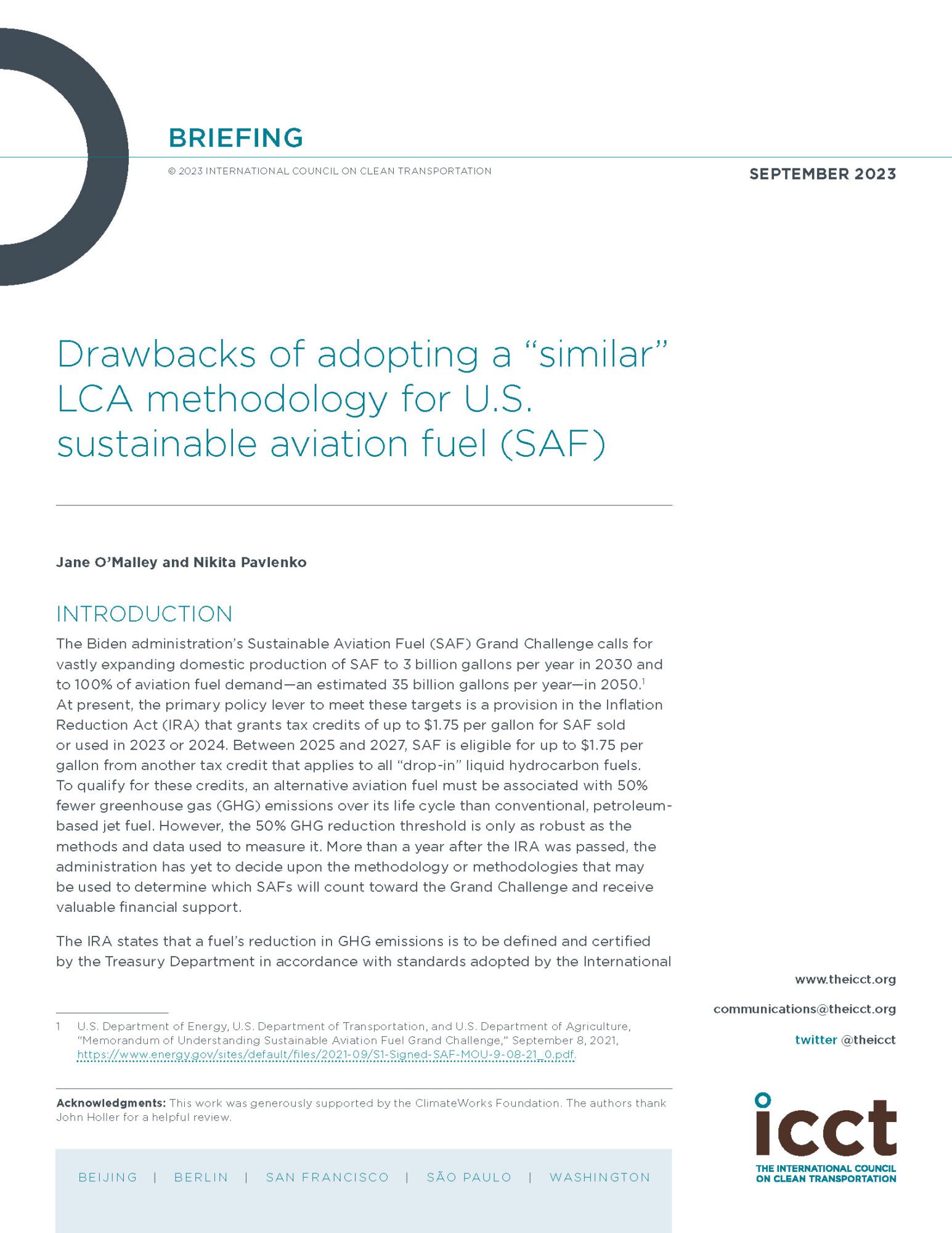Drawbacks of adopting a “similar” LCA methodology for U.S. sustainable aviation fuel (SAF)
Blog
How Treasury’s recent guidance on the sustainable aviation fuel tax credit punted on which LCA methods are fit for takeoff
Last week brought long-awaited tax-credit guidance about sustainable aviation fuels (SAFs) from the U.S. Treasury Department. It found that, as configured, the Greenhouse Gases, Regulated Emissions, and Energy Use in Transportation (GREET) model does not “satisfy the requirements to calculate the emissions reduction percentage” to determine which fuels qualify for the lucrative credit for SAFs in the Inflation Reduction Act (IRA). In the brief guidance, Treasury also tasked multiple agencies with collaborating on an update of GREET that would fit the requirements. While this interagency working group might seem like a nod to the agricultural industry and corn ethanol producers who have been pushing for use of this model, there’s still little clarity about how life-cycle greenhouse gas (GHG) emissions will ultimately be calculated for different SAFs.
GREET can be a useful analytical tool for evaluating the life-cycle emissions of a variety of different fuels on a consistent basis, but it’s always dependent on the quality of the assumptions and inputs. In past work, the ICCT explained how using GREET can allow users to incorporate a variety of optimistic external assumptions and inputs that have not undergone regulatory scrutiny. The model has many possible configurations and data sources, and its impact on the SAF tax credit will heavily depend on the three key data inputs and assumptions discussed below. All of these will be determined by the interagency working group that will finalize the version of GREET used for the tax credit:
1. The indirect land-use change emission factor used for crop-derived biofuels. Demand for biofuels can lead to cropland expansion, but the magnitude of the expansion and the associated emissions remain the subject of vigorous academic debate. Depending on how GREET is configured, the estimated indirect land-use change (ILUC) emissions for SAF’s can range from one-quarter to one-third of the values assessed by the U.S. Environmental Protection Agency (EPA) for the Renewable Fuel Standard, by California for its Low-Carbon Fuel Standard, and by the International Civil Aviation Organization (ICAO) for its Carbon Offsetting and Reduction Scheme for International Aviation (CORSIA).
To qualify as a SAF under the IRA, a fuel’s life-cycle emissions must be below approximately 45 grams CO2e per MJ of fuel. The difference between assuming an ILUC emission factor of ~7 gCO2e/MJ and ~30 gCO2e/MJ for a feedstock like soy can make a big difference in the total emissions, all without the producer having demonstrated any improvements in their fuel-conversion process. (To view a range of possible values, see Figure 2 here.) A key outcome of the interagency working group process will be the determination of which emission factor will be used for feedstocks like corn and soy. Will it be a low estimate selected from the literature, an estimate consistent with the other regulatory assessments, or something in between?
2. The guidance around soil carbon modeling and climate-smart agricultural practices. Though carbon offsets and offset programs have recently taken somewhat of a beating in the public imagination, they’ve nevertheless attracted substantial interest from the Biden Administration, which has described activities like planting cover crops and reduced tillage of crops that have been shown to improve soils as “climate-smart” practices. However, the exact change in soil carbon that results from such practices is uncertain and difficult to credit, and a recent article in Science highlighted warnings from soil carbon modelers about the uncertainties and research gaps in their current work.
This is important because one module in the GREET model allows biofuel producers to use modeled soil carbon change estimates to credit individual biofuel projects. The size of these credits can be substantial and can allow producers to claim large emissions reductions. Rather than a conventional supply chain LCA, this module looks into the future to determine shifts in soil carbon content based on an assumed 30 years of consistent practices. Crediting these reductions would thus necessitate a new dimension to Treasury’s guidance, as Treasury would have to verify the shifts in soil carbon, ensure their permanence, and develop a system for clawing back tax credits if producers fail to keep up the promised practices for the full 30 years. Given that many existing carbon-offset schemes have recently been criticized for the lack of rigor of their soil carbon offsets, Treasury may opt to steer clear.
3. The guidelines for book-and-claim accounting for natural gas and electricity. There’s been a lot of recent focus on the “three pillars” of demonstrating renewable electricity use as it pertains to producing green hydrogen for the IRA’s 45V tax credit. Such focus is also relevant for aviation. What constitutes a “renewable” electron? Under “book-and-claim” accounting, a fuel producer can purchase the rights to renewable energy somewhere else in the economy and attribute it to their specific process. The three pillars help to create guardrails to ensure that those renewable attributes are (1) truly additional to the status quo; (2) not being double counted; and (3) are closely correlated with the energy demand for the fuel pathway. If Treasury determines that hydrogen producers must demonstrate the three pillars for the renewable electricity used to generate hydrogen, will it hold renewable inputs to SAF production to the same standard?
Depending on how flexible the guidelines are for SAF’s, producers may opt to meet their GHG reduction threshold outside of their immediate supply chain by purchasing the rights to renewable electricity or natural gas generated somewhere else. It’s even conceivable that with a particularly loose interpretation of book-and-claim without additionality safeguards, a SAF producer could purchase the rights to highly GHG negative “moo hydrogen” made from dairy manure as an input to their SAF pathway. Even if the additionality of that moo hydrogen was dubious (say, for example, the dairy biogas facility long predates the IRA), the carbon offsets for the avoided methane could be used to adjust the carbon intensity of SAF pathways looking to cross the 50% GHG reduction threshold.
As the above helps to illustrate, suggesting that GREET is a kind of definitive “method” of conducting an LCA is not much different from suggesting that Microsoft Excel is the most accurate method for conducting an LCA or that Microsoft Word is the best tool for writing a screenplay. Treasury’s recent guidance provides no answers about how the United States will ultimately handle these thorny-but-important questions. Answering them is not just a matter of collecting data and updating GREET, but also establishing the government’s tolerance for risk in assessing what constitutes a GHG reduction and what behavior justifies a tax credit. Until those questions are answered in March, we’re left with the status quo.
Author
Related Publications
DRAWBACKS OF ADOPTING A “SIMILAR” LCA METHODOLOGY FOR U.S. SUSTAINABLE AVIATION FUEL (SAF)
Highlights key differences in the life-cycle assessment (LCA) methodologies used to estimate the greenhouse gas emissions from sustainable aviation fuel.


